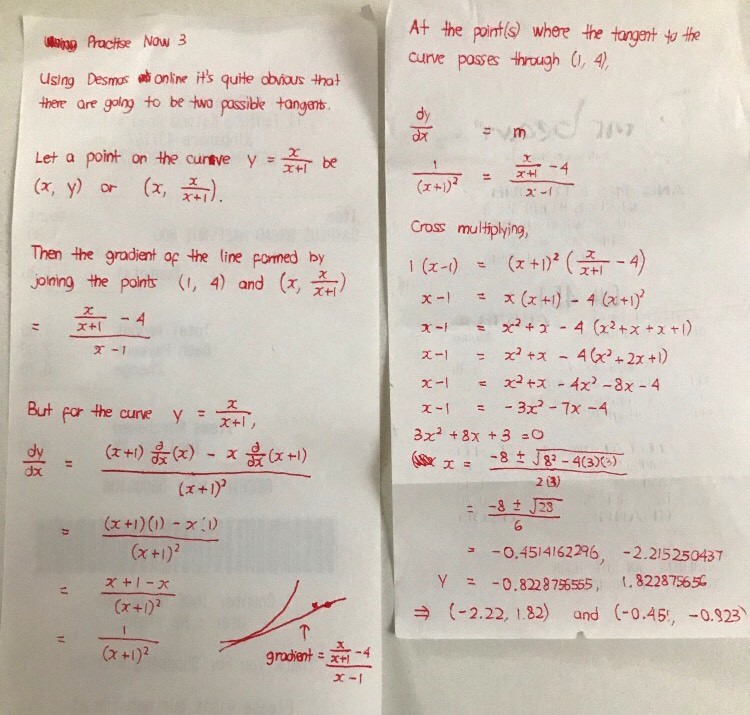Eric Nicholas K's answer to LockB's Secondary 4 A Maths Singapore question.
done
{{ upvoteCount }} Upvotes
clear
{{ downvoteCount * -1 }} Downvotes
Practise Now 3
Date Posted:
3 years ago
don't really understand why do we find the two gradients and why do we equate them together to find the coordinates....
don't really understand why do we find the two gradients and why do we equate them together to find the coordinates....
--------------------------------------------------------
In this case, we are defining the gradient of the exact same required line in two ways.
One, by considering the fact that the line is a tangent to the curve - it has a gradient (given by the expression for dy/dx) and it passes through the point (x, y).
Two, by considering the fact that we can find the gradient of the line by simply taking the gradient between two points on the line (x, y) and (1, 4). This is using the gradient formula y2 - y1 divided by x2 - x1.
Of course, you are talking about the exact same line with the same gradient, so we must equate them to solve for the value of x.
--------------------------------------------------------
In this case, we are defining the gradient of the exact same required line in two ways.
One, by considering the fact that the line is a tangent to the curve - it has a gradient (given by the expression for dy/dx) and it passes through the point (x, y).
Two, by considering the fact that we can find the gradient of the line by simply taking the gradient between two points on the line (x, y) and (1, 4). This is using the gradient formula y2 - y1 divided by x2 - x1.
Of course, you are talking about the exact same line with the same gradient, so we must equate them to solve for the value of x.
A lot of these questions which you have seen requires you to bring together many different concepts from different chapters together. And some of them, as is the case for this question, will require you to form equations to solve for x.
When you learn algebraic expressions for the first time, you first learnt how to substitute the value of x to find the value of y. This skill trains you to obtain an output value given an input value, and is clearly staightforward. You would have seen this in Primary 6, assuming you attended the Primary 6 education in Singapore.
Eventually, you are asked to find the value of x when you are provided with the value of y. This skill trains you to form equations to solve for the input value which can give us the output value. You would have seen this in Secondary 1.
These are the same thing, but finding the input value (in Sec 1) is much harder than finding the output value (in Pri 6), simply because it works that way,
Here in differentiation, it's the same, First, you are asked to find the value of dy/dx when provided with the value of x.
Afterwards, like the case here, you are asked to find the value of x which leads to a certain expression. Being able to formulate equations to solve for an unknown x is very critical in A Maths.
When you learn algebraic expressions for the first time, you first learnt how to substitute the value of x to find the value of y. This skill trains you to obtain an output value given an input value, and is clearly staightforward. You would have seen this in Primary 6, assuming you attended the Primary 6 education in Singapore.
Eventually, you are asked to find the value of x when you are provided with the value of y. This skill trains you to form equations to solve for the input value which can give us the output value. You would have seen this in Secondary 1.
These are the same thing, but finding the input value (in Sec 1) is much harder than finding the output value (in Pri 6), simply because it works that way,
Here in differentiation, it's the same, First, you are asked to find the value of dy/dx when provided with the value of x.
Afterwards, like the case here, you are asked to find the value of x which leads to a certain expression. Being able to formulate equations to solve for an unknown x is very critical in A Maths.
we can use one point on the curve to find the coordinates of 2 different tangent points? sorry this question is really confusing me...
dont really understand the part on "let a point on the curve...." and "then the gradient of the tangent formed...."
"we can use one point on the curve to find the coordinates of 2 different tangent points? sorry this question is really confusing me..."
---------------------------------------------------------
For this question, the graph is actually a little unusual, in the sense that there are actually TWO possible points on the curve which can be drawn together with the point (1, 4) separately in two different straight lines to form two entirely different tangent lines which can satisfy the question.
---------------------------------------------------------
"dont really understand the part on "let a point on the curve...." and "then the gradient of the tangent formed....""
--------------------------------------------------------
You need to define a random point (x, y) to be connected to the point (1, 4) with a straight line so that you can find the gradient of the straight line using the gradient formula (y2 - y1) / (x2 - x1).
"The gradient of the line formed" is simply this formula being used here.
After using the formula, you get gradient = (y - 4) / (x - 1).
But then, this point is not just any random point (x, y) on the graph. It must be a point lying on the curve y = x / (x + 1). So, the y-coordinate of the curve must of course be x / (x + 1) for any given value of x. This is why the coordinate becomes what I wrote.
---------------------------------------------------------
For this question, the graph is actually a little unusual, in the sense that there are actually TWO possible points on the curve which can be drawn together with the point (1, 4) separately in two different straight lines to form two entirely different tangent lines which can satisfy the question.
---------------------------------------------------------
"dont really understand the part on "let a point on the curve...." and "then the gradient of the tangent formed....""
--------------------------------------------------------
You need to define a random point (x, y) to be connected to the point (1, 4) with a straight line so that you can find the gradient of the straight line using the gradient formula (y2 - y1) / (x2 - x1).
"The gradient of the line formed" is simply this formula being used here.
After using the formula, you get gradient = (y - 4) / (x - 1).
But then, this point is not just any random point (x, y) on the graph. It must be a point lying on the curve y = x / (x + 1). So, the y-coordinate of the curve must of course be x / (x + 1) for any given value of x. This is why the coordinate becomes what I wrote.



